The Booming Business Of Biomimicry
by: fast company, 2011-11-14 16:11:12 UTC
Economists are trying to quantify both the spread of the 15-year-old biomimicry industry and its economic effects, and the results are eye-opening.
Introduced in 2010, the Da Vinci Index is an attempt to quantify the impact of biomimicry in the U.S. Compiled by Lynn Reaser, chief economist at Point Loma Nazarene University's Fermanian Business & Economic Institute in San Diego, the Da Vinci Index measures the use of terms unique to biomimimetic thinking in scientific publications, patents, and grants (PDF).
The most recent update of the Da Vinci index, released in the third quarter of 2011, shows an eleven-fold increase in the incidence of biomimicry in the research pipeline since 2000, the baseline year of the index.
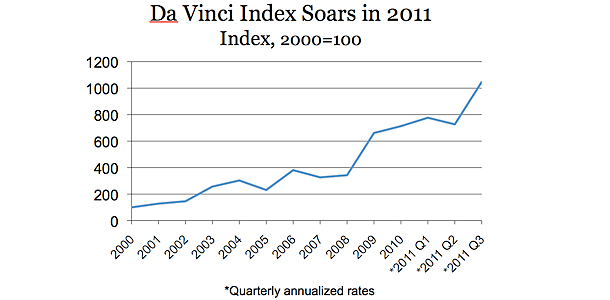
One caveat: The methodology used to build the Da Vinci index can't distinguish between the spread of terms related to biomimicry and the spread of biomimetic thinking itself. This isn't entirely a bad thing--even though humans have always looked to nature for inspiration, the term "biomimicry" carries with it dimensions of sustainable thinking that might otherwise be absent from the innovations to which it's being attached.
That's embodied by the index itself, which characterizes biomimetic thinking as being about higher efficiency, lower costs, and "optimizing, not maximixing." That last bit is key--natural systems cope with resource limitations all the time, and there's more evidence than ever that the explosive fossil-fueled growth of the 20th century has already given way to a 21st century characterized by gains in productivity achieved primarily through increased efficiency, not more resource use.
This means the Da Vinci index is in a way a measurement of research into sustainability practices. As the initial report on the index put it, "…by increasing efficiency and reducing costs, solutions inspired by nature can allow us to both raise standards of living and preserve the environment."
This report was commissioned by the San Diego Zoo, which has already created a new revenue stream by marketing its expertise in biomimicry to corporations. The Zoo is also actively involved in the establishment of an "innovation hub" that could lead to biomimicry-focused research.
These efforts to build a consortium of biomimicry-focused businesses and research institutions mean that this report is probably on the sunny side of estimates of the potential economic impact of biomimicry. That said, here are the numbers its authors propose:
By 2025, biomimicry could represent: $300 billion annually of U.S. GDP (2010 dollars), $50 billion value in terms of resources conserved and CO2 not emitted, and 1.6 million jobs. Globally, the report projects that biomimicry could account for $1 trillion in GDP by 2025. That's as big as the entire U.S. oil and gas industry, which employs 9 million Americans.
Those benefits won't be evenly distributed across all industries. And the ones that fare best are a measure of the extent to which some fields have been the most avid adopters of biomimetic processes.
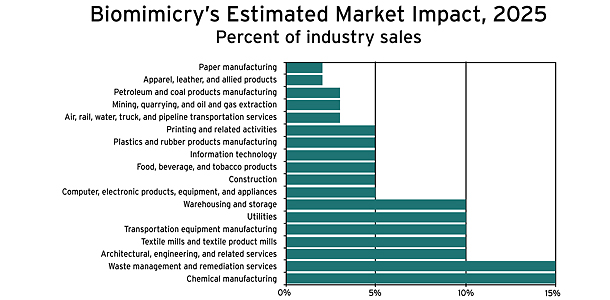
Chemical manufacturing might seem like a surprise leader, but it shouldn't be. Responding as much to the wildly fluctuating costs of its primary feedstock (oil) as much as anything else, engineers have developed methods for "green" chemistry at a rapid clip. Novozymes, for example, manufactures the active ingredients in detergent from sugar, in gigantic fermentation vats.
Waste management is an obvious place for biomimicry to creep in, considering that waste management is in some respects the whole of what nature does. From recycling and composting to recovery of landfill gas, it's an industry where there's an enormous amount of low-hanging fruit.
At the bottom of this index are the extractive and transportation industries. Precisely because we have yet to fundamentally rethink how we use fossil fuels or transport ourselves and our goods, these are the industries with the most to gain from biomimicry. It could also be argued that these are the activities that are central to the difference between humans and all the life that preceded us on earth, which had to suffice on the calories it could extract from its immediate environment, rather than the deep past, in the form of fossil fuels.
[Image: Flickr user Z33]


 Making Cement The Way Coral Does It: Out Of Thin Air
Making Cement The Way Coral Does It: Out Of Thin Air
by: fast company, 2011-11-14 17:08:09 UTC
The creation of cement is an incredibly polluting process, but Stanford scientist Bret Constanz has found a way to mimic the way coral works, by creating cement from CO2 and water.
Biomineralization expert Brent Constantz of Stanford University got inspiration from the way corals build reefs to make a new type of cement for buildings. The process of making this cement actually removes carbon dioxide--a greenhouse gas, thought to cause global warming--from the air. The company Constantz founded, called Calera, has a demonstration plant on California's Monterrey Bay that takes waste CO2 gas from a local power plant and dissolves it into seawater to form carbonate, which mixes with calcium in the seawater and creates a solid. It's how corals form their skeletons, and how Constantz creates cement.
[video_twistage 1]
[Image: Flickr user Dawn Endico]


 Atos to Use SAP Sustainability App; Greenstone Updates Acco2unt
Atos to Use SAP Sustainability App; Greenstone Updates Acco2unt
by: Environmental Leader, 2011-11-14 11:40:03 UTC

International IT services company Atos will use SAP BusinessObjects Sustainability Performance Management application to manage its sustainability performance, the companies announced at the SAPPHIRE NOW + SAP TechEd Madrid conference. Atos plans to roll out the sustainability reporting to sites across 42 countries in early 2012, and will offer the SAP service to its customers [...]
 3E Adds CDR Services, GC3 Builds Chemical Data Portal for Retailers
3E Adds CDR Services, GC3 Builds Chemical Data Portal for Retailers
by: Environmental Leader, 2011-11-14 11:20:41 UTC

EH&S compliance and information management services provider 3E Company has released a new services suite aimed to assist businesses with disclosure processes and chemical data reporting (CDR) compliance issues. The service comes in response to recent updates to the EPA’s chemical reporting requirements. The CDR Rule was passed in August 2011, and in June 2011, [...]
 marco sousa santos: shell chair
marco sousa santos: shell chair
by: Designboom - Weblog, 2011-11-12 13:55:00 UTC
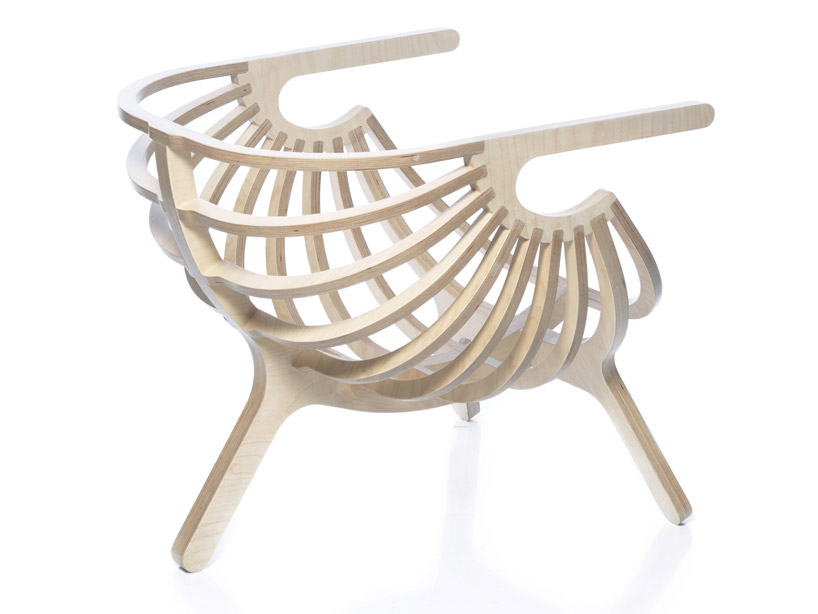
an array of curved plywood pieces create a vessel for pillows and cushions allowing each user to personalize their own cocoon.
read more
suzanne lee: eco-textile fashion
by: Designboom - Weblog, 2011-11-13 12:02:00 UTC

bacterial cellulose fermentation constructs finished works of fashion grown in a bath of sugary green tea.
read more
Wheels: SEAT all-electric car
by: Ecofriend, 2011-11-14 04:46:36 UTC
Srikanth Belide:

SEAT all-electric carThe SEAT all-electric car
The green machine
Due to globalization, usage of the technology has increased rapidly. Things get completed at faster rate with the efficient use of technology. But this rapid growth has created many problems such as an increase in pollution. Basically by the usage of automobiles that are driven with the help of petrol or diesel are mostly responsible for this. Due to the soot, known as carbon monoxide released by the vehicles, has many poisonous chemicals which are very dangerous, which indeed decreases the lifespan.
Usage of electric cars is the best suitable solution to this problem. They are eco friendly. They can be driven using electricity, which does not release any harmful chemicals into the surroundings. South African company named SEAT is striving very hard to bring the car of one of this type. It had given the presentation about this kind of model named SEAT Leon twin drive in 2009 in front of Spanish government and some of Volkswagen officials. Main reason for developing eco friendly car is to decrease the air pollution, and to reduce the effect of global warming.
Green factor
SEAT electric car is designed with environmentally friendly tuned combustion engine, thereby reducing the effect of pollution. It doesn’t emit any of the harmful gases which are not good for the environment. It has all the features that usually a luxurious car has. This car is modified version of SEAT Leon , with different gear box, different fuel. Main aim of this car is low consumption of power and to produce environmental friendly carbon monoxide levels. The SEAT Leon model discussed here will use ingenious twin drive technology hence the name SEAT Leon twin drive.
The powertrain
It is designed with an electric motor with 35Kw of output, converted to Hp its output is 47Hp not too bad. The electric motor is combined with internal combustion engine. The internal combustion engine is used in here to generate the electric power by spinning of the electric motor, which is used either to recharge the batteries or power the motor drives directly. Its main intention is to develop Plug in electric powered vehicles.
Coming to its performance, its maximum speed is 100km/h. For a short distance you can use Li-ion batteries. it gives nearly50-70 km with full charging of battery or by full usage of internal combustion engine. The present model has range of 50 km based on full battery charge. It is very economical when compared to presently used fuels like petrol and diesel.
The highs
The important feature of this electric car is that it is driven by electricity and not by the natural fuels like petrol, ethanol,gasoline which are very dangerous to atmosphere. Not only this SEAT leon twin drive but also many hybrid electric cars have been developed to decrease the air pollution which in turn decreases the global-warming. Toyota high lander hybrid, Chevrolet silverado hybrid, Saturn vue green line comes under this category.
The lows
Range of presently discussed model by SEAT is only 50 km with fully charged battery, which is very low. Need to be recharged for every 50km. So this car is not presently suitable for long drive of 400-500 km. It also Produces very low power.Initial cost is very high.
Cost and availability
Initial cost of the SEAT leon twin drive is around 9.5 lacs. As it requires an electric motor with internal combustion engine initial cost is more. This electric car is available by the end of 2014. This is very useful contribution by SEAT.
The efficient usage of this electric car can be done only if is maintained well. Time to time recharging of the discharged battery must be done. Never neglect it, if not recharged instantaneously the life span of the electric motor decreases, which in turn decreases the car performance. Hence maintaining the car is most important thing to be noted. What ever SEAT is doing is only to reduce the air pollution which is the basic cause for many health problems. This car finds a new path to full fill our dreams. It even provides all the luxuries, it is a 5 door ,5 seat hatchback model. Good maintenance of the car can yield good results.


 The BuildingGreen Guide to Insulation Products and Practices Should Be On Every Designer's Virtual Bookshelf. (Book Review)
The BuildingGreen Guide to Insulation Products and Practices Should Be On Every Designer's Virtual Bookshelf. (Book Review)
by: TreeHugger Design, 2011-11-11 18:37:00 UTC

Insulation is complex, controversial, critical to conservation and too often ignored. The BuildingGuide Is a big help, if not the conclusive answer.
CRP Racing Unveil Energica E-Superbike at Italian Motorbike Show
by: Inhabitat , 2011-11-11 19:20:33 UTC

Electric superbikes enable bikers to travel the roads knowing they are both cool and environmentally friendly. While prototypes have been developed to break speed records, there still isn’t a commercial version available for the average consumer. However CRP Racing have unveiled a prototype e-superbike at the EICMA motorcycle show in Italy that could be hitting the roads in the near future.


Read the rest of CRP Racing Unveil Energica E-Superbike at Italian Motorbike Show
Permalink |
Add to
del.icio.us |
digg
Post tags: CRP Racing, CrpRacing, eicma 2011, Eicma2011, electric, electric bikes, electric motorbikes, Energica, ev, freezer, green bikes, green motorbikes, italy, LCD, LED, motorcycle, prototype, streetbike
Toto’s Poop Bike NEO Completes Its 870 Mile Journey Across Japan!
by: Inhabitat , 2011-11-11 22:54:54 UTC

We are so excited to learn that the amazing Toilet Bike Neo has completed its poop-powered 870 mile journey across Japan! Earlier this year, top toilet maker Toto unveiled their talking three-wheeled motorcycle, which includes a much laughed-about but only decorative toilet seat, as part of their plan to half their company’s carbon emissions by 2017. The motorbike is fueled by a combination of household sewage and livestock waste converted into an ecologically-friendly biogas that is stored in tanks at the back of the bike!





Read the rest of
Toto’s Poop Bike NEO Completes Its 870 Mile Journey Across Japan!
Permalink |
Add to
del.icio.us |
digg
Post tags: biogas, eco design, green design, green transportation, Japan, LED lights, livestock waste, NEO, poop, poop power, sewage, sustainable design, talking bike, toilet bike neo, toto



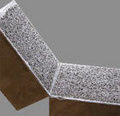


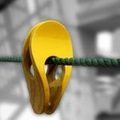


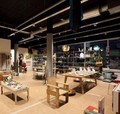
Comments by our Users
Be the first to write a comment for this item.